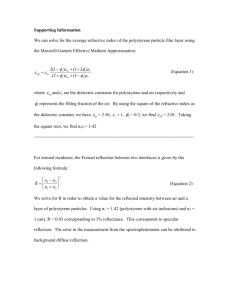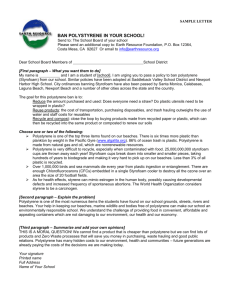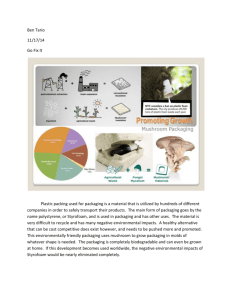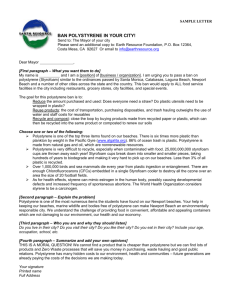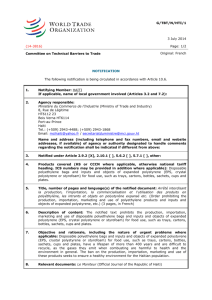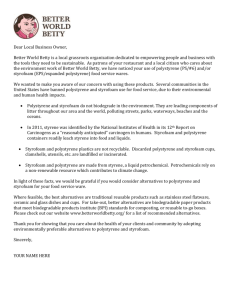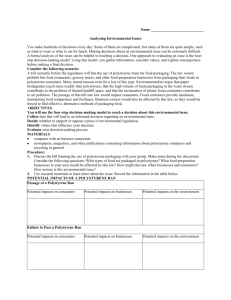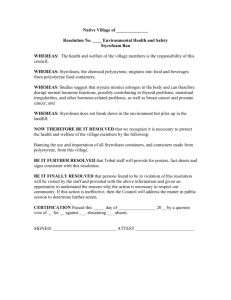Expanded Polystyrene and a 100
advertisement
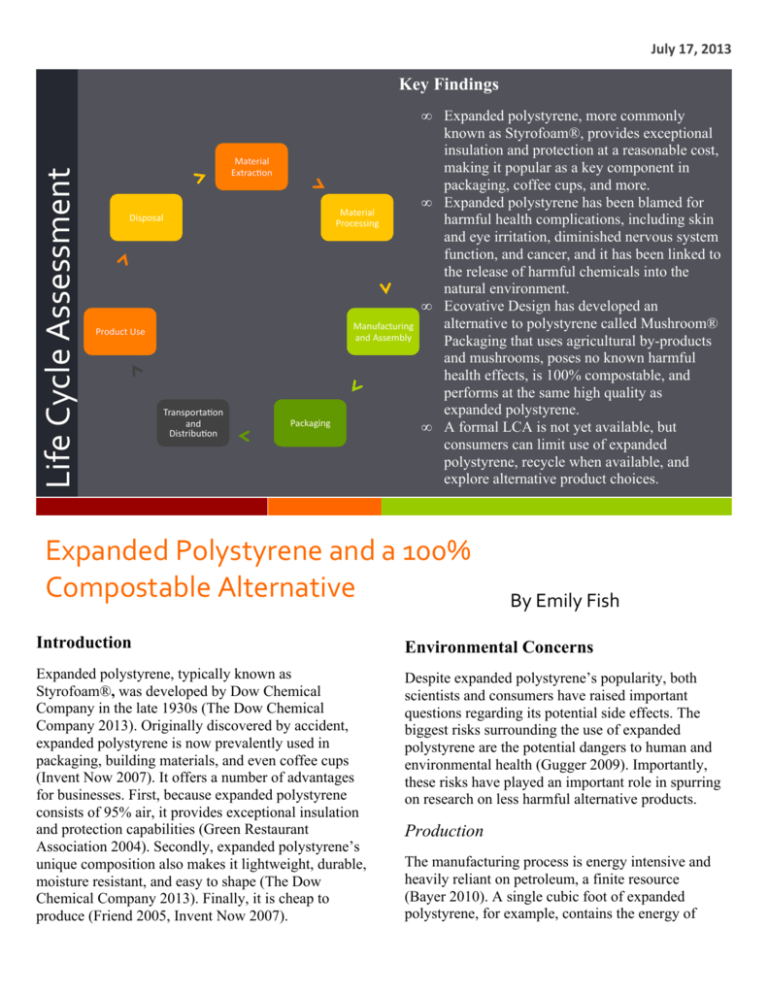
! July!17,!2013! Key Findings Material( Extrac,on( • Material( Processing( Disposal( • Manufacturing( and(Assembly( Product(Use( Transporta,on( and( Distribu,on( Packaging( % Life%Cycle%Assessment% • • Expanded polystyrene, more commonly known as Styrofoam®, provides exceptional insulation and protection at a reasonable cost, making it popular as a key component in packaging, coffee cups, and more. Expanded polystyrene has been blamed for harmful health complications, including skin and eye irritation, diminished nervous system function, and cancer, and it has been linked to the release of harmful chemicals into the natural environment. Ecovative Design has developed an alternative to polystyrene called Mushroom® Packaging that uses agricultural by-products and mushrooms, poses no known harmful health effects, is 100% compostable, and performs at the same high quality as expanded polystyrene. A formal LCA is not yet available, but consumers can limit use of expanded polystyrene, recycle when available, and explore alternative product choices. Expanded%Polystyrene%and%a%100%% Compostable%Alternative% % By%Emily%Fish% Introduction Environmental Concerns Expanded polystyrene, typically known as Styrofoam®, was developed by Dow Chemical Company in the late 1930s (The Dow Chemical Company 2013). Originally discovered by accident, expanded polystyrene is now prevalently used in packaging, building materials, and even coffee cups (Invent Now 2007). It offers a number of advantages for businesses. First, because expanded polystyrene consists of 95% air, it provides exceptional insulation and protection capabilities (Green Restaurant Association 2004). Secondly, expanded polystyrene’s unique composition also makes it lightweight, durable, moisture resistant, and easy to shape (The Dow Chemical Company 2013). Finally, it is cheap to produce (Friend 2005, Invent Now 2007). Despite expanded polystyrene’s popularity, both scientists and consumers have raised important questions regarding its potential side effects. The biggest risks surrounding the use of expanded polystyrene are the potential dangers to human and environmental health (Gugger 2009). Importantly, these risks have played an important role in spurring on research on less harmful alternative products. Production The manufacturing process is energy intensive and heavily reliant on petroleum, a finite resource (Bayer 2010). A single cubic foot of expanded polystyrene, for example, contains the energy of ! July!17,!2013! ! about 1.5 liters of petroleum (Bayer 2010). This is roughly the amount needed for a 20-mpg car to travel 8 miles. This rapid use and disposal of petroleum brings up additional concerns about national security and the increasing financial and political costs of purchasing petroleum from an unstable outside sources. In 1986 the EPA documented a total of 57 chemicals released during the production process making it the fifth largest contributor of hazardous waste that year (Green Restaurant Association 2004, Gugger 2009). Toxic Release Inventory reports from 1992 show that 32.8 million pounds of styrene were released into the natural environment that year, with the majority being released to the atmosphere and smaller amounts being released to land and waterways, while more recent reports show significant reductions following implementation of new technologies (Office of Pollution Prevention and Toxics (OPPT) Chemical Fact Sheets 1994, Styrene Information & Research Center). Additionally, expanded polystyrene manufacturing and the associated use of hydrofluorocarbons have negatively affected the Earth’s changing climate1 (Frazier). Yet, recent advancements at Dow Chemical Company may mitigate these concerns. In short, Dow recently modified several large polystyrene plants in Texas, Illinois, and Missouri to use “zero ozone-depleting” technology. The company cites these changes as a step toward achieving their 2015 Sustainability Goals, but the changes will also result in a safer product for both the public and the environment. (The Dow Chemical Company 2013). (Missouri Department of Natural Resources 2011) of years to decompose. As part of the decomposition process, expanded polystyrene products break apart into smaller pieces that are easily transported by wind and water into natural environments downwind or downstream, where animals are likely to choke on or block their digestive systems with the expanded polystyrene pieces (Green Restaurant Association 2004). While some of these harmful effects from disposal can be mitigated with proper recycling of expanded polystyrene products, few recycling centers exist that are capable of recycling the material (Green Restaurant Association 2004). Importantly, there is no expanded polystyrene recycling center in Fort Collins, CO, however there are several options available through ACH Foam Technologies. Consumers can choose drop-off or mail-in options at any of their facilities, one of which is located in Denver, CO2 (ACH Foam Technologies 2007). This recycling option excludes any food-service products, which may represent a significant amount of an individual’s expanded polystyrene use, and consumers are urged to check with the specific location before delivering foam products, as ACH is strict about the types of products they will handle. While many cities have enacted either partial or full bans on foam products (No Foam Chicago 2010), a recent attempt in New York is making national headlines. New York City Mayor Michael Bloomberg has announced his plan to ban foam cups and food containers, saying that the foam is Disposal Many expanded polystyrene products are thrown into landfills on a regular basis, which quickly depletes already dwindling supplies of both petroleum and landfill space (Bayer 2010). Because expanded polystyrene is largely composed of air, it takes up a substantial amount of the volume at today’s landfills (Bayer 2010). Once in a landfill, expanded polystyrene products are believed to take anywhere from thousands (Bayer 2010) to millions 1 2 2! ! Source: Astrofoam, Inc. Hydrofluorocarbons are highly reactive, making them potent greenhouse gases ACH Foam Technologies Denver is located at 5250 N. Sherman St. Denver, CO 80216 (phone: 303-297-3844)( ! July!17,!2013! ! “something that we know is environmentally destructive and that may be hazardous to our health, that is costing taxpayers money and that we can easily do without, and is something that should go the way of lead paint” (Deprez and Goldman 2013). Boulder, CO is beginning to make moves to ban expanded polystyrene products with much of the support coming from University of Colorado students – a local prohibition on banning the “use or sale of specific plastic materials or products” has temporarily stalled the ban’s progress, but members of the community are working hard to change local law (Hernandez 2013). Health Concerns Styrene, the main component of expanded polystyrene, comes from benzene, a known carcinogen, with well-documented history of health impacts (Green Restaurant Association 2004, National Toxicology Program 2011). The 1986 EPA National Human Adipose Tissue Survey found trace amounts of styrene in 100% of the human fat tissue samples randomly selected from the general public – small increases in exposure have been linked to numerous health issues described below (Ewall 1996). Just two years later, the Foundation for Advancements in Science and Education found very similar results. The styrene found in this second study was present in human fat tissue at “one third of levels known to cause neurotoxic symptoms” (Ewall 1996). The presence of such a highly processed material in human tissue is concerning to many consumers, particularly when exposure to expanded polystyrene is difficult to avoid. Oftentimes exposure occurs when expanded polystyrene leaches its toxic chemicals into food contained in disposable containers, particularly those heated in microwaves, but there are many other opportunities for exposure as well. Concerns surrounding expanded polystyrene’s impacts on human health are not just applicable to the consumers, but also to the manufacturers who work in close contact with the material. Studies of the health effects of styrene on factory workers have shown a connection between expanded polystyrene exposure and possible increases in leukemia and lymphoma incidences as well as an increased risk of spontaneous abortion (Office of Pollution Prevention and Toxics Chemical Fact Sheets 1994). Other studies found that regular exposure to expanded polystyrene can cause irritation to skin and eyes (Frazier). The chemicals released in the production process has been shown to pose a risk to human reproductive systems along with risks of depression, gastrointestinal problems, and decreased kidney functioning (Green Restaurant Association 2004). Additionally, animal studies have shown a host of additional risks, including nervous system problems and liver, lung, and nasal toxicity in rodents (International Agency for Research on Cancer 2002). It should be noted that critics highlight a number of methodological limitations to these studies including: small sample sizes, potential biases, and a variety of other confounding factors. In fact, they explain that the expanded polystyrene used in food storage containers has been tested and approved as safe by the United States Food and Drug Administration (Plastic Foodservice Facts 2010). Despite disagreements amongst members of the scientific community, the sheer volume of studies showing problematic health effects of expanded polystyrene has fueled a search for alternatives. Alternative Option A promising alternative to expanded polystyrene uses a combination of mushrooms and agricultural waste. Ecovative Design3 produces an expanded polystyrene alternative that is 100% compostable – typically by adding the material to a home or commercial composting system.4 The final product has shown to perform at the same high quality of traditional expanded polystyrene products (Bayer 2010). 3 Ecovative Design’s primary facility in New York runs on carbon neutral hydroelectric power, resulting in an even more energy efficient process. 4 Fort Collins commercial composting options include Clean Air Compost (phone: 970-224-4732) as well as several similar options in neighboring towns. In the absence of commercial companies, simple home composting options are available: http://eartheasy.com/grow_compost.html, http://www2.epa.gov/recycle/composting-home) ! 3! ! July!17,!2013! ! Table 1: Benefits of Mushroom® Packaging by Life Cycle Phase( Production Use Low energy, water, and resource No known health or consumption environmental risks Opportunity for upcycling5 of local Performs at same high quality crop waste as expanded polystyrene ( Comparatively, Mushroom® Packaging’s life cycle impact is much ‘greener’ than that of Styrofoam® (Table 1). The process begins with each production facility selecting their local feedstock, which can vary depending on the agricultural waste available at each site. In North America, common feedstocks are buckwheat husks and oat hulls, although many local options are available. The selected feedstock is then cleaned, pasteurized, and inoculated with mycelium.6 The mixture is poured into a mold of any shape and left to sit in a dark area for 5-7 days. During this time, the mycelium digests the crop waste and fills the area of the mold with dense fibers. The final product is then dehydrated to stop all growth and to eliminate the potential for spore and allergen production (Ecovative Design 2013). Many of these products are available to consumers as samples in Ecovative Design’s online store. Additionally, the company has partnered with Sealed Air North America to provide an opportunity for businesses to request custom products from its website7 (Sealed Air 2013). Ecovative Design is currently working with the United States Food and Drug Administration to release a safe food storage container. Disposal 100% compostable at home or in commercial facilities Eliminates need for landfills servers. Finally, Ecovative Design has begun working with the National Oceanic and Atmospheric Administration (NOAA) to implement their mycelium technology in NOAA’s buoy platforms meant to provide early warning of tsunamis to costal communities (Mushroom® Packaging 2013). Conclusions and Recommendations While Ecovative Design is still in the process of releasing a Mushroom® Packaging Life Cycle Assessment, consumers may be able to use the information above to evaluate the two options. To summarize, if a business requires only limited contact with expanded polystyrene and if there is an expanded polystyrene recycling facility nearby, it may still be the best business option to continue using expanded polystyrene due to its costs and availability. On the other hand, if an organization frequently uses expanded polystyrene products and there is no nearby qualified recycling centers, Mushroom® Packaging may be a highly attractive alternative. The product, Mushroom® Packaging, performs so well that Steelcase, Inc., a major fortune 500 company, has switched from using expanded polystyrene products to using Mushroom® Packaging to protect furniture shipments. Dell is also now working with Ecovative Design to protect its sophisticated and fragile 200-pound computer 5 Upcycling is commonly defined as using a product that would otherwise be considered trash to make something entirely ( new (Binder 2009) 6 The root-like structure of a mushroom known as the mycelium. The mycelium is essentially self-assembling with no need for light, water, chemicals, or heavy machinery (Bayer 2010). 7 Consumers interested in purchasing custom products can find more information at: http://www.sealedairprotects.com/NA/EN/products/foam_packaging/restore-mushroom.aspx 4! ! ( ! July!17,!2013! ! Resources • • • • • • • A Fort Collins-based commercial and residential curbside compost pick-up service http://www.cleanaircompost.com Easy to use searchable directory of composting facilities throughout the United States http://findacomposter.com City of Fort Collins resources on composting food waste at home http://www.fcgov.com/recycling/composting.php Details on several options for recycling expanded polystyrene through EPS Industry Alliance Packaging - http://www.epspackaging.org/index.php?option=com_content&view=article&id=8&Itemid=4 Learn more about Ecovative Design LLC’s production process and current projects http://www.ecovativedesign.com Learn more about both standard and custom Mushroom Packaging products http://www.mushroompackaging.com Watch a 9 minute TED Talk video from Eben Bayer, co founder of Ecovative Design LLC – http://www.ted.com/talks/eben_bayer_are_mushrooms_the_new_plastic.html Acknowledgements We would like to thank Colorado State University’s Center for Multiscale Modeling of Atmospheric Processes and the National Science Foundation for funding this research. We would also like to thank ClimateWise (Fort Collins, CO), especially Matt Gibbs, for helping us to define the scope and scale of our research and allowing us to present our findings at a community outreach event. Lastly, we would like to thank Michele Betsill and Jonathan Fisk for their help throughout the entire research and writing process. This work has been supported by the National Science Foundation Science and Technology Center for Multi-Scale Modeling of Atmospheric Processes, managed by Colorado State University under cooperative agreement No. ATM-0425247. ( ! 5! ! July!17,!2013! Works Cited ACH Foam Technologies. "Recycle Expanded Polystyrene (EPS)." Environmental. ACH Foam Technologies, 2007. Web. 24 June 2013. <http://www.achfoam.com/recycle-eps.aspx>. Astrofoam, Inc. "Stock Boxes/Coolers." Custom Molded Packaging Solutions. Astrofoam, Inc., 2012. Web. 22 July 2013. <http://www.astrofoam.com/stock_boxes_coolers.htm>. Bayer, Eben. "Are Mushrooms the New Plastic?" Lecture. TEDGlobal 2010. England, Oxford. July 2010. TED. TED Conferences LLC, Oct. 2010. Web. 19 July 2013. <http://www.ted.com/talks/eben_bayer_are_mushrooms_the_new_plastic.html>. Binder, Libuse. "Ecovative Design: Making Magic Out of Mushrooms." Earth911. Earth 911: More Ideas, Less Waste, 11 May 2009. Web. 19 June 2013. <http://earth911.com/news/2009/05/11/making-magic-out-ofmushrooms/>. Deprez, Esme E., and Henry Goldman. "Bloomberg Pushes for Plastic-Foam Ban in ‘State of the City’." Bloomberg. Bloomberg L.P., 14 Feb. 2013. Web. 24 June 2013. <http://www.bloomberg.com/news/2013-02-14/bloomberg-to-push-for-styrofoam-ban-in-final-nycstate-of-city-.html>. The Dow Chemical Company. Dow. The Dow Chemical Company, 2013. Web. 18 June 2013. <http://www.dow.com>. Ecovative Design LLC. Ecovative Design. Ecovative Design LLC, 2013. Web. 19 June 2013. < http://www.ecovativedesign.com>. Environmental Protection Agency. "Styrene." Technology Transfer Network Air Toxics Web Site. United States Environmental Protection Agency, Jan. 2000. Web. 19 June 2013. <http://www.epa.gov/ttnatw01/hlthef/styrene.html>. Ewall, Mike. "Polystyrene & Health Homepage." Polystyrene & Health Homepage. EJnet.org: Web Resources for Environmental Justice Activists, 4 Mar. 1996. Web. 19 June 2013. <http://www.ejnet.org/plastics/polystyrene/health.html>. Frazier, Karen. "How Styrofoam Is Bad for the Environment." LoveToKnow: Green Living. LoveToKnow, n.d. Web. 19 June 2013. <http://greenliving.lovetoknow.com/How_Styrofoam_is_Bad_for_the_Environment>. Friend, Duane. "The Pros and Cons of Styrofoam." Land and Water: Conserving Natural Resources in Illinois. University of Illinois Extension: College of Agricultural, Consumer and Environmental Sciences, Feb. 2005. Web. 24 June 2013. <http://abe-research.illinois.edu/pubs/factsheets/Styrofoam.pdf>. Green Restaurant Association. "Polystyrene Foam Report." Earth Resource Foundation. Earth Resource Foundation, 2004. Web. 18 June 2013. <http://www.earthresource.org/campaigns/capp/cappstyrofoam.html>. Gugger, Michelle. "Climate for Action: Choosing an Alternative to Polystyrene." It's Our Environment: EPA's Blog About Our World. EPA Greenversations, 24 Mar. 2009. Web. 19 June 2013. <http://blog.epa.gov/blog/2009/03/climate-for-action-choosing-an-alternative-to-styrofoam/>. !6( ! July!17,!2013! ! ( Hernandez, Lance. "CU Student Launches Grassroots Effort to Ban Use of Polystyrene Food Containers in Boulder." 7News - The Denver Channel. American Broadcasting Company, 20 Feb. 2013. Web. 08 July 2013. <http://www.thedenverchannel.com/news/front-range/boulder/cu-student-begins-grassrootseffort-to-ban-use-of-polystyrene-food-containers-in-boulder>. International Agency for Research on Cancer. "Styrene Fact Sheet: Support Document." Summaries and Evaluations. International Programme on Chemical Safety, 2002. Web. 19 June 2013. <http://www.inchem.org/documents/iarc/vol82/82-07.html>. Invent Now. "Otis Ray McIntire." National Inventors Hall of Fame. Invent Now, 2007. Web. 24 June 2013. <http://www.invent.org/2008induction/1_3_08_induction_mcintire.asp>. Missouri Department of Natural Resources. "Litter Facts and Research." No MOre Trash! Missouri Department of Conservation, 2011. Web. 19 June 2013. <http://extra.mdc.mo.gov/nomoretrash/facts/>. Mushroom Packaging. "Case Studies." Mushroom Packaging. Ecovative Design LLC, 2013. Web. 24 June 2013. <http://www.mushroompackaging.com/packaging-solutions/case-studies>. National Toxicology Program. "Benzene." Report on Carcinogens. National Toxicology Program, 2011. Web. 24 June 2013. <http://ntp.niehs.nih.gov/ntp/roc/twelfth/profiles/Benzene.pdf>. No Foam Chicago. "Cities That Have Banned Styrofoam Food Packaging." Bans Across The US. No Foam Chicago, 2010. Web. 24 June 2013. <http://nofoamchicago.org/BansAcrossUS.html>. Office of Pollution Prevention and Toxics (OPPT) Chemical Fact Sheets. "Styrene Fact Sheet: Support Document." OPPT Chemical Fact Sheets. United States Environmental Protection Agency, Dec. 1994. Web. 19 June 2013. <http://www.epa.gov/chemfact/styre-sd.pdf>. Plastic Foodservice Facts. "Safety of Polystyrene Foodservice Products." Plastic Foodservice Facts. American Chemistry Council, 2010. Web. 24 June 2013. <http://plasticfoodservicefacts.com/main/Safety/Safetyof-PS-Foodservice-Products>. Sealed Air. "Restore Mushroom Packaging." Sealed Air Protects. Sealed Air, 2013. Web. 24 June 2013. <http://www.sealedairprotects.com/NA/EN/products/foam_packaging/restore-mushroom.aspx>. Styrene Information & Research Center. "EPA's Toxic Release Inventory (TRI)." Styrene. Styrene Information & Research Center, n.d. Web. 08 July 2013. http://www.styrene.org/regulatory/tri.html. ! 7!
